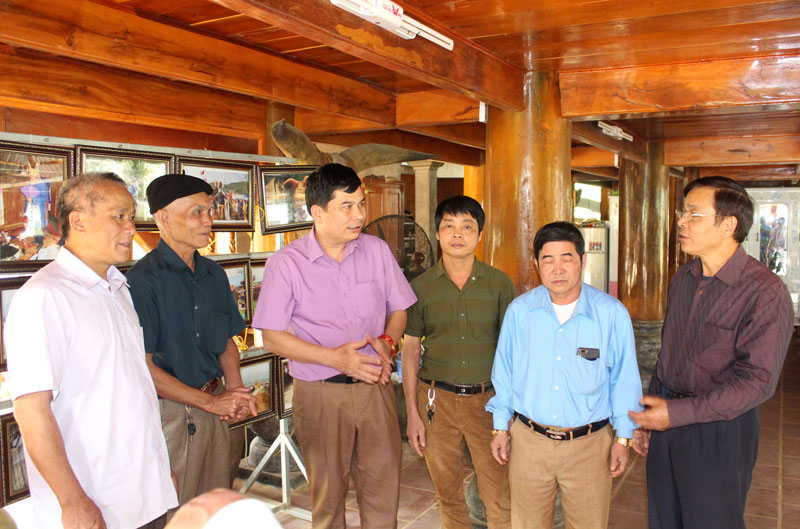
(HBO) - Formerly being a Secretary of the District’s Party Committee, however, he is more well-known among the people in Lac Son district as the person collecting the ancient folk songs of Muong ethnic people which are in danger of disappearing in the flow of culture and life.
 Mr. Bui Van Nom (the external from the right) and his
associates when contacting, studying and collecting Mo songs, the old folk
songs of Muong ethnic people in Van Son commune (Lac Son).
Mr. Bui Van Nom (the external from the right) and his
associates when contacting, studying and collecting Mo songs, the old folk
songs of Muong ethnic people in Van Son commune (Lac Son).
Following the distinguished culture researcher and artisan,
Mr. Bui Huy Vong, we visited Mr. Bui Van Nom, the former Secretary of Lac Son
District’s Party Committee. There are full of books about history and culture
he has been collecting over the years on his desk. The sound of the rhythms of
Rang Thuong singing, love song singing (responsive singing) is peaceful,
melodious and gentle from the small speakers mounted on the column. Mr. Bui Huy Vong says these are old songs. It is
one of the peaks of Muong folk language expressed in a rustic but extremely deep
and emotional voice by the elderly artists of Muong Vang region. Thanks to Mr.
Nom, Lac Son district has been collecting and preserving many traditional folk
songs of Muong ethnic people.
The treasure of folk tunes and ancient music that Bui Van
Nom has worked so hard to gather, and the folk researchers and artisans
collecting them during the past years can be considered to be "massive”. The
folk songs, love songs, or Thuong Dang and Bo Met singing are all stored in the
form of recordings and video recordings. These are all ancient lyrics, only the
elderly people know and know how to sing them, and now they are in danger of
disappearing. It is worth saying that "without the effort of Mr. Bui Van Nom,
it is likely that a lot of folk songs would have completely disappeared and
could not be found. Because many people have followed their ancestors to Muong
Ma already. Those are extremely valuable documents,” the folklore researcher
and artist, Mr. Bui Huy Vong said.
Talking with us, Mr. Bui Van Nom also says that currently
the collection team has gathered, collected and saved hundreds of audio and
video recordings with a duration of about 70 hours of responsive singing, in
which there are songs that last from morning till night. Along with that, there
are hundreds of high quality audio and video recordings of over 100 hours of
folk artists’ performance. In addition, there are hundreds of old songs with
lyrics and languages bearing a literary image.
With an increasingly vibrant and widespread emulation movement aimed at building cultured residential areas and cultured families, Yen Thuy District has been making steady progress toward improving both the material and spiritual well-being of its people, while fostering a civilized, prosperous, beautiful, and progressive community.
Once lacking recreational spaces and community facilities, Residential Group 2 in Quynh Lam Ward (Hoa Binh City) has recently received attention for the construction of a new, spacious, and fully equipped cultural house. The project followed the model of state support combined with public contributions in both labor and funding.
The "All people unite to build cultural life" movement, which has been effectively integrated with Kim Boi district’s socio-economic development goals, is fostering a lively spirit of emulation across local residential areas, hamlets, villages, public agencies, and enterprises. In addition, through the initiative, traditional cultural values are being preserved and promoted, while community solidarity and mutual support in poverty reduction and economic development are being strengthened.
A working delegation of the Hoa Binh provincial People’s Committee led by its Permanent Vice Chairman Nguyen Van Toan on June 11 inspected the progress of a project to build the Mo Muong Cultural Heritage Conservation Space linked to tourism services in Hop Phong commune, Cao Phong district.
Born and growing in the heroic land of Muong Dong, Dinh Thi Kieu Dung, a resident in Bo town of Kim Boi district, in her childhood was nurtured by the sweet lullabies of her grandmother and mother. These melodies deeply imprinted on her soul, becoming an inseparable part of her love for her ethnic group's culture. For over 20 years, this love for her hometown has driven Dung to research, collect, and pass down the cultural values of the Muong people to future generations.
In the final days of May, the Ethnic Art Troupe of Hoa Binh Province organized performances to serve the people in remote, mountainous, and particularly disadvantaged areas within the province. These were not just ordinary artistic shows, but they were the meaningful journeys aimed at spreading cultural values, enhancing the spiritual life of the people and contributing to the preservation of ethnic minority cultural identities.



 Mr. Bui Van Nom (the external from the right) and his
associates when contacting, studying and collecting Mo songs, the old folk
songs of Muong ethnic people in Van Son commune (Lac Son).
Mr. Bui Van Nom (the external from the right) and his
associates when contacting, studying and collecting Mo songs, the old folk
songs of Muong ethnic people in Van Son commune (Lac Son).